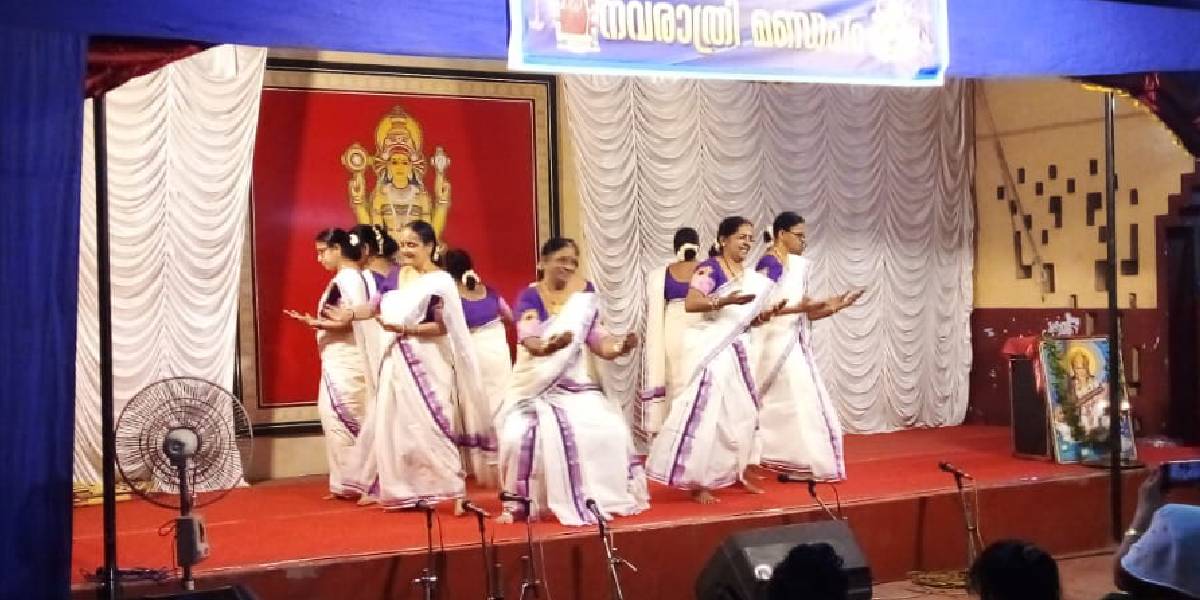A group of women, all aged above 40, performed Kaikottikali, a dance form of Kerala, at the Durga Temple in Ollur, Thrissur, as part of the Navaratri celebrations.
Published Oct 20, 2024 | 9:00 AM ⚊ Updated Oct 20, 2024 | 9:00 AM

Sree Durga Kaikottikali Sangam performing at the Durga Temple in Ollur, Thrissur.
In the days leading up to Navaratri, a group of women in Thrissur, Kerala, began regular practice of dance – their instructor was also a teacher at a local primary school.
Each day, the group of 20 women – many of them over 50 years old – would gather for practice, and carefully rehearse what is generally known as a folk dance – Kaikottikali. The group goes by the name ‘Sree Durga Kaikottikali Sangam’.
The troupe, with 10 members from the team, performed at the Durga Temple in Ollur, Thrissur, on 10 October, where an audience of about 100 gathered to watch.
The group dance came at the end of a programme of music and dance, specially held during Navaratri.
The Warrier Samajam was organising the event at the temple, and many of the performers – and even members of the audience – formed a large network of relatives.
Kaikottikali is a flowing, languid style of dance, much less vigorous than its more famous Gujarati cousin, Dandiya.
K Gouri, 85, who had danced this dance as a child, remembers that the steps would be rather more vigorous when she was a child. “We would sit and then leap to the music to clap hands with the person partnering us, it was much more demanding of suppleness,” she says.
She agrees that the women performing at the Durga Temple were all about 40 or older, and could not be expected to perform with the suppleness of a teenager.
Kaikotti – in Malayalam, the word means clap, and kali is play. And many of the steps in the dance involve movements that end with the dancers clapping either their own hands or those of others dancing with them.
The music that accompanies the dance requires clapping too, and the coordinated steps and regular clapping quite clearly are a cause of simple, pure joy.
This dance form, the older members of the audience remember, was never performed on stage – it was a folk dance that had passed down generations, and traditionally, younger girls learnt by just performing with those who already knew the dance.
“When we were young, there was no stage. There would be people performing, and we too would just get swept into the whirl of the dance – even when we did not know the steps. With time, everybody just learnt along the way,” says Gouri.
These days, as people dance rarely, even though there is a proliferation of video clips of youngsters dancing, there is a need for some practice, some regular discipline to the performance. Large gatherings where dances begin spontaneously do not happen anymore.
It was clear that the dancers had all been put through hours of regular practice, so in sync were all the performers. There were even some women who sang the song that was playing on the music system along with the dance – clearly, there were some performers who had danced to the song so many times that they had become the dance.
What was unique about the gathering on 10 October was that it was a large audience that could trace ties of family – apart from the group Kaikottikali, there were Kuchipudi, Bharatnatyam and Mohiniyattam performances, and several men on stage, singing.
At one point, as a singer’s name was announced as the next performer, one saw an elderly man spring out of his chair and vanish – members of the audience remarked that the man’s wife had been called to perform next, and he had probably been “fried” at home with her practice sessions.
Apart from the performances, the first-time visitor would also notice the venue – the hall was part of a temple complex, the Edakunni Kshetram. The whole area had been well conserved, through continuous use across generations. It was astounding that such a range of cultural expression could be mastered to such levels of near-professionalism.
From toddlers bouncing their way through the audience to elderly people who rested their walking sticks on the wall before taking a seat, it was a joy to witness one vast family coming together in song and dance as part of worship.
Susheela Venugopal, the schoolteacher who is also the Kaikottikali teacher, was the main organiser of the programme. Her’s was the voice making all the announcements at the main event.
Her home is the venue of the dance practice, and members of the troupe expressed their gratitude for her generosity – her day job and her evening practice routines leave her with little time, and she takes on all the extra responsibility for the sheer joy of bringing people together in performance.
There is no fee for the dance classes, and these days, there are also people beyond the family circle seeking to learn.
Practice happens only once or twice a week in the normal course, but ahead of performances and during Navaratri, the practice sessions are a daily ritual.
“Once we finish this year’s performances at a few nearby temples, we will set about learning new steps for the next season,” says Smita Ramanathan, one of the performers.
(Edited by Majnu Babu).
